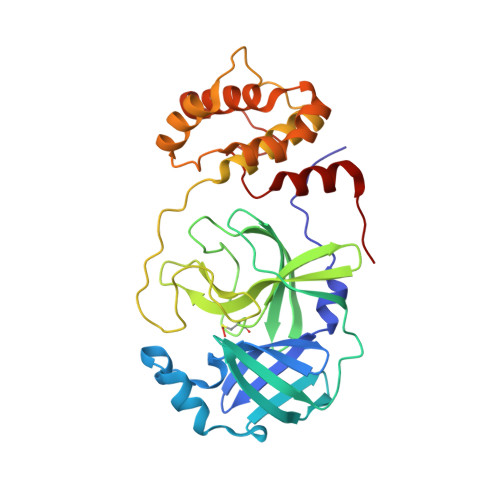Room-temperature X-ray crystallography reveals the oxidation and reactivity of cysteine residues in SARS-CoV-2 3CL M pro : insights into enzyme mechanism and drug design.
Kneller, D.W., Phillips, G., O'Neill, H.M., Tan, K., Joachimiak, A., Coates, L., Kovalevsky, A.(2020) IUCrJ 7
- PubMed: 33063790
- DOI: https://doi.org/10.1107/S2052252520012634
- Primary Citation of Related Structures:
6XB0, 6XB1, 6XB2, 6XHU - PubMed Abstract:
The emergence of the novel coronavirus SARS-CoV-2 has resulted in a worldwide pandemic not seen in generations. Creating treatments and vaccines to battle COVID-19, the disease caused by the virus, is of paramount importance in order to stop its spread and save lives. The viral main protease, 3CL M pro , is indispensable for the replication of SARS-CoV-2 and is therefore an important target for the design of specific protease inhibitors. Detailed knowledge of the structure and function of 3CL M pro is crucial to guide structure-aided and computational drug-design efforts. Here, the oxidation and reactivity of the cysteine residues of the protease are reported using room-temperature X-ray crystallography, revealing that the catalytic Cys145 can be trapped in the peroxysulfenic acid oxidation state at physiological pH, while the other surface cysteines remain reduced. Only Cys145 and Cys156 react with the alkylating agent N -ethylmaleimide. It is suggested that the zwitterionic Cys145-His45 catalytic dyad is the reactive species that initiates catalysis, rather than Cys145-to-His41 proton transfer via the general acid-base mechanism upon substrate binding. The structures also provide insight into the design of improved 3CL M pro inhibitors.
Organizational Affiliation:
Neutron Scattering Division, Oak Ridge National Laboratory, 1 Bethel Valley Road, Oak Ridge, TN 37831, USA.
















